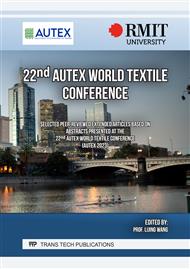[1]
Shepherd, R. F.; Ilievski, F.; Choi, W.; Morin, S. A.; Stokes, A. A.; Mazzeo, A. D.; Chen, X.; Wang, M.; Whitesides, G. M.: Multigait soft robot. Proceedings of the National Academy of Sciences of the United States of America 108(2011)51, S. 20400–20403.
DOI: 10.1073/pnas.1116564108
Google Scholar
[2]
Yang, S.; Lu, N.: Gauge factor and stretchability of silicon-on-polymer strain gauges. Sensors (Basel, Switzerland) 13(2013)7, S. 8577–8594.
DOI: 10.3390/s130708577
Google Scholar
[3]
Pfeil, S.; Katzer, K.; Kanan, A.; Mersch, J.; Zimmermann, M.; Kaliske, M.; Gerlach, G.: A Biomimetic Fish Fin-Like Robot Based on Textile Reinforced Silicone. Micromachines 11(2020)3
DOI: 10.3390/mi11030298
Google Scholar
[4]
Shih, B.; Christianson, C.; Gillespie, K.; Lee, S.; Mayeda, J.; Huo, Z.; Tolley, M. T.: Design Considerations for 3D Printed, Soft, Multimaterial Resistive Sensors for Soft Robotics. Frontiers in robotics and AI 6(2019), S. 30.
DOI: 10.3389/frobt.2019.00030
Google Scholar
[5]
Stoppa, M.; Chiolerio, A.: Testing and evaluation of wearable electronic textiles and assessment thereof (Hrsg.): Performance Testing of Textiles. Elsevier, 2016. - ISBN 9780081005705, S. 65–101.
DOI: 10.1016/b978-0-08-100570-5.00005-0
Google Scholar
[6]
Viry, L.; Levi, A.; Totaro, M.; Mondini, A.; Mattoli, V.; Mazzolai, B.; Beccai, L.: Flexible three-axial force sensor for soft and highly sensitive artificial touch. Advanced materials (Deerfield Beach, Fla.) 26(2014)17, S. 2659-64, 2614.
DOI: 10.1002/adma.201305064
Google Scholar
[7]
Mersch, J.; Winger, H.; Nocke, A.; Cherif, C.; Gerlach, G.: Experimental Investigation and Modeling of the Dynamic Resistance Response of Carbon Particle‐Filled Polymers. Macromolecular Materials and Engineering 305(2020)10, S. 2000361.
DOI: 10.1002/mame.202000361
Google Scholar
[8]
Huang, C.-T.; Shen, C.-L.; Tang, C.-F.; Chang, S.-H.: A wearable yarn-based piezo-resistive sensor. Sensors and Actuators A: Physical 141(2008)2, S. 396–403.
DOI: 10.1016/j.sna.2007.10.069
Google Scholar
[9]
Quintero, A. Vásquez; Camara, M.; Mattana, G.; Gaschler, W.; Chabrecek, P.; Briand, D.; Rooij, N. F. de: Capacitive Strain Sensors Inkjet-printed on PET Fibers for Integration in Industrial Textile. Procedia Engineering 120(2015), S. 279–282.
DOI: 10.1016/j.proeng.2015.08.613
Google Scholar
[10]
Calvert, P.; Duggal, D.; Patra, P.; Agrawal, A.; Sawhney, A.: Conducting Polymer and Conducting Composite Strain Sensors on Textiles. Molecular Crystals and Liquid Crystals 484(2008)1, S. 291/[657]-302/[668].
DOI: 10.1080/15421400801904690
Google Scholar
[11]
Nilsson, E.; Lund, A.; Jonasson, C.; Johansson, C.; Hagström, B.: Poling and characterization of piezoelectric polymer fibers for use in textile sensors. Sensors and Actuators A: Physical 201(2013), S. 477–486.
DOI: 10.1016/j.sna.2013.08.011
Google Scholar
[12]
Dargahi, J.; Kahrizi, M.; Purushotham Rao, N.; Sokhanvar, S.: Design and microfabrication of a hybrid piezoelectric‐capacitive tactile sensor. Sensor Review 26(2006)3, S. 186–192.
DOI: 10.1108/02602280610675465
Google Scholar
[13]
Hofmann, P.; Walch, A.; Arnold-Keifer, S.; Selvarayan, S. Kumar; Gresser, G. T.: Utilization of the textile reinforcements of fiber reinforced plastics as sensor for condition monitoring. Composites Part A: Applied Science and Manufacturing 126(2019), S. 105603.
DOI: 10.1016/j.compositesa.2019.105603
Google Scholar
[14]
Gries,T.: Elastische Textilien, Frankfurt am Main: Dt. Fachverl., 2005. -ISBN 3-87150-852-7.
Google Scholar
[15]
Mersch, J.; Cuaran, C. A. Gomez; Vasilev, A.; Nocke, A.; Cherif, C.; Gerlach, G.: Stretchable and Compliant Textile Strain Sensors. IEEE Sensors Journal 21(2021)22, S. 25632–25640.
DOI: 10.1109/jsen.2021.3115973
Google Scholar
[16]
Cataldo, A.; Benedetto, E. de; Cannazza, G.: Advances in Reflectometric Sensing for Industrial Applications. Synthesis Lectures on Emerging Engineering Technologies 2(2016)1, S. 1–96.
DOI: 10.2200/s00691ed1v01y201512eet002
Google Scholar
[17]
Monitoring deformation in rock and soil with TDR sensor cables. 2003.
Google Scholar
[18]
Lin, M. W.; Abatan, A. O.; Zhou, Y.: High-sensitivity electrical TDR distributed strain sensor. In: Smart Structures and Materials 2000: Sensory Phenomena and Measurement Instrumentation for Smart Structures and Materials, Newport Beach, CA, Monday 6 March 2000, S. 463.
DOI: 10.1117/12.388137
Google Scholar
[19]
O'Connor, K. M.; Murphy, E. W.: TDR monitoring as a component of subsidence risk assessment over abandoned mines. International Journal of Rock Mechanics and Mining Sciences 34(1997)3-4, S. 230.e1-230.e15.
DOI: 10.1016/s1365-1609(97)00134-2
Google Scholar
[20]
Aimone-Martin, C. T.; Francke, J. L.: Time domain reflectometry (TDR): A comparison of field data to laboratory shear tests. International Journal of Rock Mechanics and Mining Sciences 34(1997)3-4, S. 84.e1-84.e15.
DOI: 10.1016/s1365-1609(97)00093-2
Google Scholar
[21]
Dowding, C. H.; O'Connor, K. M.: Comparison of TDR and Inclinometers for Slope Monitoring: American Society of Civil Engineers, 2012.
Google Scholar
[22]
Lin, M. W.; Thaduri, J.; Abatan, A. O.: Development of an electrical time domain reflectometry (ETDR) distributed strain sensor. Measurement Science and Technology 16(2005)7, S. 1495–1505.
DOI: 10.1088/0957-0233/16/7/012
Google Scholar
[23]
Marotta Mapa, L.; Fernandes Golin, A.; Cavalcante Costa, C.; Bianchi, R. Fernando: The use of complex impedance spectroscopy measurements for improving strain sensor performance. Sensors and Actuators A: Physical 293(2019), S. 101–107.
DOI: 10.1016/j.sna.2019.02.001
Google Scholar
[24]
Xu, D.; Tairych, A.; Anderson, I. A.: Localised strain sensing of dielectric elastomers in a stretchable soft-touch musical keyboard. In: Electroactive Polymer Actuators and Devices (EAPAD) 2015, San Diego, California, United States, Sunday 8 March 2015, S. 943025.
DOI: 10.1117/12.2084770
Google Scholar



